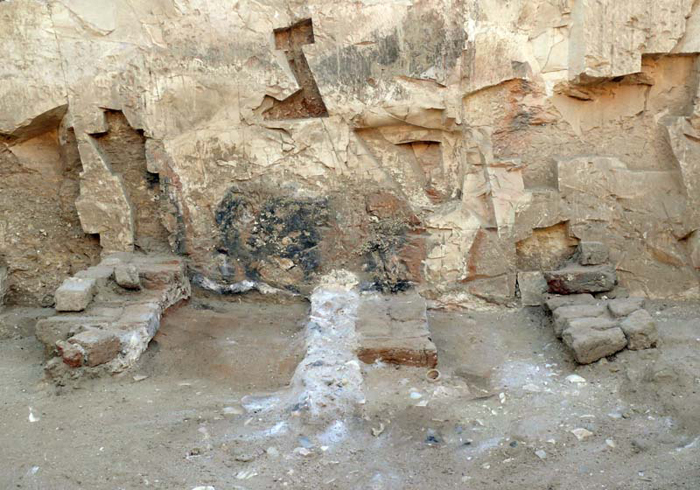Remains of 'End of the World' Epidemic Found in Ancient Egypt

Archaeologists have uncovered the remains of an epidemic in Egypt so terrible that one ancient writer believed the world was coming to an end.
Working at the Funerary Complex of Harwa and Akhimenru in the west bank of the ancient city of Thebes (modern-day Luxor) in Egypt, the team of the Italian Archaeological Mission to Luxor (MAIL) found bodies covered with a thick layer of lime (historically used as a disinfectant). The researchers also found three kilns where the lime was produced, as well as a giant bonfire containing human remains, where many of the plague victims were incinerated.
Pottery remains found in the kilns allowed researchers to date the grisly operation to the third century A.D., a time when a series of epidemics now dubbed the "Plague of Cyprian" ravaged the Roman Empire, which included Egypt. Saint Cyprian was a bishop of Carthage (a city in Tunisia) who described the plague as signaling the end of the world. [See Photos of the Remains of Plague Victims & Thebes Site]
Occurring between roughly A.D. 250-271, the plague "according to some sources killed more than 5,000 people a day in Rome alone," wrote Francesco Tiradritti, director of the MAIL, in the latest issue of Egyptian Archaeology, a magazine published by the Egypt Exploration Society.
Tiradritti's team uncovered the remains of this body-disposal operation between 1997 and 2012. The monument his team is excavating was originally built in the seventh century B.C. for a grand steward named Harwa. After Harwa's death, the Egyptians continuously used the monument for burial (Akhimenru was a successor who built his own tomb there). However, after its use for body disposal during the plague, the monument was abandoned and never used again.
The use of the complex "for the disposal of infected corpses gave the monument a lasting bad reputation and doomed it to centuries of oblivion until tomb robbers entered the complex in the early 19th century," Tiradritti writes.
End of the world
Get the world’s most fascinating discoveries delivered straight to your inbox.
Cyprian left a gut-wrenching record of what the victims suffered before they died. "The bowels, relaxed into a constant flux, discharge the bodily strength [and] a fire originated in the marrow ferments into wounds of the fauces (an area of the mouth)," he wrote in Latin in a work called "De mortalitate." The "intestines are shaken with a continual vomiting, [and] the eyes are on fire with the injected blood," he wrote, adding that "in some cases the feet or some parts of the limbs are taken off by the contagion of diseased putrefaction …"
Cyprian believed that the world was coming to an end.
"The kingdom of God, beloved brethren, is beginning to be at hand; the reward of life, and the rejoicing of eternal salvation, and the perpetual gladness and possession lately lost of paradise, are now coming, with the passing away of the world …" (translation by Philip Schaff, from the book "Ante-Nicene Fathers", volume 5, 1885).
While the world, of course, did not end, the plague weakened the Roman Empire. "It killed two Emperors, Hostilian in A.D. 251 and Claudius II Gothicus in A.D. 270," wrote Tiradritti. It is "a generally held opinion that the 'Plague of Cyprian' seriously weakened the Roman Empire, hastening its fall." [In Photos: 14th-Century 'Black Death' Grave Discovered]
The newly unearthed remains at Luxor underscore the plague's potency. Tiradritti'steam found no evidence that the victims received any sort of religious rites during their incineration. "We found evidence of corpses either burned or buried inside the lime," he told Live Science in an interview. "They had to dispose of them without losing any time."
What caused the plague?
The plague may have been some form of smallpox or measles, accordingto modern day scientists. While the discovery of human remains associated with the plague will give anthropologists new material to study, Tiradritti cautions they will not be able to extract DNA from the bodies.
While stories about researchers extracting DNA from mummies (such as Tutankhamun) have made headlines in recent years, Tiradritti told Live Science he doesn't believe the results from such ancient specimens. "In a climate like Egypt, the DNA is completely destroyed," he said. DNA breaks down over time, and permafrost (something not found in Egypt) is the best place to find ancient DNA samples, Tiradritti said.
Immense monument
The discovery of the body disposal site is just one part of the team's research. Thebes is a massive site containing a vast necropolis, and the excavations of the MAIL are providing new data that allows scholars to determine how it changed between the seventh century B.C. and today.
The funerary complex of Harwa and Akhimenru, which the MAIL has been excavating since 1995, is one of the largest private funerary monuments of Egypt. Tiradritti notes that it is considered a key monument for studying a peak period in Egyptian art known as the "Pharaonic Renaissance" that lasted from the start of the seventh century B.C. until the mid-sixth century B.C. During this time, Tiradritti notes, artists created innovative new works that were rooted in older Egyptian artistic traditions.
Follow Live Science @livescience, Facebook & Google+. Originally published on Live Science.

Owen Jarus is a regular contributor to Live Science who writes about archaeology and humans' past. He has also written for The Independent (UK), The Canadian Press (CP) and The Associated Press (AP), among others. Owen has a bachelor of arts degree from the University of Toronto and a journalism degree from Ryerson University.



